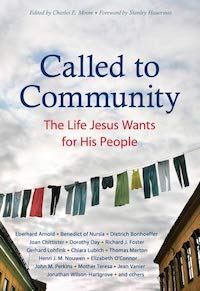Bearing One Another’s Burdens by Amy Nicholson

Called to Community:
The Life Jesus Wants for His People
Edited by Charles E. Moore
Plough, 2016
$18 359 pp.
If we really want peace for the world, let us start by loving one another within our families.
– Mother Teresa
It is an interesting time to read a book about community. The world is in the midst of the Covid-19 pandemic. We are self-isolating and social distancing. Our definition of community is vastly different from what it was four months ago when the pandemic began deconstructing our lives.
In his introduction to Called to Community: The Life Jesus Wants for His People, editor Charles E. Moore writes that “destruction of community has only been compounded by the advance of digital technology.” I have to disagree. During the pandemic, the opposite has been true: we have relied on technology to preserve whatever shreds of community we have left, whether it is a church service held over Zoom, a school classroom gathering through Google Meet, or a small group or even a family Easter dinner held virtually. If it weren’t for computers, we would have lost touch with all our communities around the middle of March.
Moore’s purpose for compiling this anthology is to explore what can be done to create meaningful communities. His central premise is that the answer lies with God’s people. “Only when the church lives out its original calling, as a contrast community and foretaste of God’s coming reign, is there hope for the world,” he writes. “In [Christ] relationships can be healed and transformed.”
The collection of essays is organized in four parts. Part I presents the biblical vision of community; part II defines community; part III addresses problems and challenges that arise in communities; and part IV discusses what it means for the community to live outside itself. Each essay was written by someone with experience living in community. Some of these writers were familiar to me, including Dietrich Bonhoeffer, Henri J. M. Nouwen, Fyodor Dostoyevsky, and Mother Teresa. Others were unfamiliar, such as Eberhard Arnold, who founded the Bruderhof community of which Moore is a member.
This is an ideal book for a reader interested in pursuing life in a Christian intentional community. But it is also a good resource for the rest of us who desire to live out more fully Jesus’s ideal of community in whatever groups we already find ourselves. Although I read the book on my own, the author suggests it be studied collaboratively, for the sake of actually building the type of community the various contributors envision. In addition to the 52 essays there is a discussion guide, which could be used by a weekly book club over the course of a calendar year.
In his introduction, Moore asks, “Are we ready and eager for a new work of the Spirit in which everything, including our lifestyles and corporate structures, is turned upside down?” In this time of the pandemic, when our idea of community is already turned upside down, when we are using technology to bring us together rather than wall us apart, when we are not so much looking away from people and using our technological devices as avoidance mechanisms, but peering into our screens to see the eyes of those we love and miss, seeking connection—yes, we might answer, maybe we are ready for a new work of the Spirit.
Moore contrasts our modern independent life with the early Christian church in his own contribution to the volume, the essay “It Takes Work.” “How are we to put up with each other unless we relate closely enough to get on each other’s nerves?” he asks. This was the lockdown in a nutshell. Many of us were isolated in our homes and forced to “put up with each other.” Did we find ourselves merely coexisting with our family, each of us in our own room doing our own thing on our own time, maybe just passing in the hall on the way to brush our teeth? Or did we find ourselves “bearing one another’s burdens,” to echo Paul in Galatians 5:13? Maybe we cared for a loved one who was ill or ran errands for someone who was immunocompromised. If we empathize and sacrifice, give of our time and resources—even to those in our own home—it will be good practice for when we can gather in our external communities again.
Even though we will not all be called to the kind of communal Christian living the authors in this book experienced, we will, at some time in our lives, belong to some form of community, be it a church, school, club, civic organization, or simply a state or town. As I write this, in the wake of the pandemic, some churches are still closed and only holding services online. Schools have been closed since March, and everyone is talking about what our educational communities will look like going forward. For months we have been unable to meet regularly in groups, whether in public or in our own home. We have been “forced” back into our homes—in essence, our core community.
Whether we belong to an outside community or not, we were all born into some kind of family. How is Jesus calling us to live with one another in that family? This collection challenges us to re-envision community and to see it as Jesus did: a place of empathy, compassion, and self-sacrifice. Are we up for the challenge?
Amy Nicholson hopes to encourage and inspire others through her writing. She has been published in Country Woman, the Old Schoolhouse, the Lookout, and other publications. In addition to writing and discovering grace in ordinary places, Amy substitute teaches. Visit her at: www.amynicholson14.wordpress.com.




Leave a Reply
Want to join the discussion?Feel free to contribute!